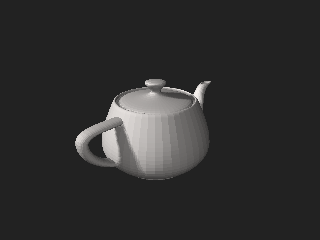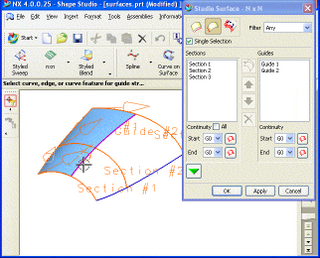Related Research Articles

A Bézier curve is a parametric curve used in computer graphics and related fields. A set of discrete "control points" defines a smooth, continuous curve by means of a formula. Usually the curve is intended to approximate a real-world shape that otherwise has no mathematical representation or whose representation is unknown or too complicated. The Bézier curve is named after French engineer Pierre Bézier (1910–1999), who used it in the 1960s for designing curves for the bodywork of Renault cars. Other uses include the design of computer fonts and animation. Bézier curves can be combined to form a Bézier spline, or generalized to higher dimensions to form Bézier surfaces. The Bézier triangle is a special case of the latter.

Vector graphics are a form of computer graphics in which visual images are created directly from geometric shapes defined on a Cartesian plane, such as points, lines, curves and polygons. The associated mechanisms may include vector display and printing hardware, vector data models and file formats, as well as the software based on these data models. Vector graphics are an alternative to raster or bitmap graphics, with each having advantages and disadvantages in specific situations.

Computer-aided design (CAD) is the use of computers to aid in the creation, modification, analysis, or optimization of a design. This software is used to increase the productivity of the designer, improve the quality of design, improve communications through documentation, and to create a database for manufacturing. Designs made through CAD software help protect products and inventions when used in patent applications. CAD output is often in the form of electronic files for print, machining, or other manufacturing operations. The terms computer-aided drafting (CAD) and computer-aided design and drafting (CADD) are also used.

Pierre Étienne Bézier was a French engineer and one of the founders of the fields of solid, geometric and physical modelling as well as in the field of representing curves, especially in computer-aided design and manufacturing systems. As an engineer at Renault, he became a leader in the transformation of design and manufacturing, through mathematics and computing tools, into computer-aided design and three-dimensional modeling.

The Utah teapot, or the Newell teapot, is a 3D test model that has become a standard reference object and an in-joke within the computer graphics community. It is a mathematical model of an ordinary Melitta-brand teapot that appears solid with a nearly rotationally symmetrical body. Using a teapot model is considered the 3D equivalent of a "Hello, World!" program, a way to create an easy 3D scene with a somewhat complex model acting as the basic geometry for a scene with a light setup. Some programming libraries, such as the OpenGL Utility Toolkit, even have functions dedicated to drawing teapots.

Autodesk Alias is a family of computer-aided industrial design (CAID) software predominantly used in automotive design and industrial design for generating class A surfaces using Bézier surface and non-uniform rational B-spline (NURBS) modeling method.
In the field of 3D computer graphics, a subdivision surface is a curved surface represented by the specification of a coarser polygon mesh and produced by a recursive algorithmic method. The curved surface, the underlying inner mesh, can be calculated from the coarse mesh, known as the control cage or outer mesh, as the functional limit of an iterative process of subdividing each polygonal face into smaller faces that better approximate the final underlying curved surface. Less commonly, a simple algorithm is used to add geometry to a mesh by subdividing the faces into smaller ones without changing the overall shape or volume.
Paul de Casteljau was a French physicist and mathematician. In 1959, while working at Citroën, he developed an algorithm for evaluating calculations on a certain family of curves, which would later be formalized and popularized by engineer Pierre Bézier, leading to the curves widely known as Bézier curves.

Freeform surface modelling is a technique for engineering freeform surfaces with a CAD or CAID system.

Jos Stam is a researcher in the field of computer graphics, focusing on the simulation of natural physical phenomena for 3D-computer animation. He achieved technical breakthroughs with the simulation of fluids and gases, new rendering algorithms and subdivision surfaces, which are a mix between two previously incompatible worlds of Nurbs- and polygon-modeling in 3D.
In computer-aided geometric design a control point is a member of a set of points used to determine the shape of a spline curve or, more generally, a surface or higher-dimensional object.
Brian A. Barsky is a professor at the University of California, Berkeley, working in computer graphics and geometric modeling as well as in optometry and vision science. He is a Professor of Computer Science and Vision Science and an Affiliate Professor of Optometry. He is also a member of the Joint Graduate Group in Bioengineering, an inter-campus program, between UC Berkeley and UC San Francisco.

Geometrical design (GD) is a branch of computational geometry. It deals with the construction and representation of free-form curves, surfaces, or volumes and is closely related to geometric modeling. Core problems are curve and surface modelling and representation. GD studies especially the construction and manipulation of curves and surfaces given by a set of points using polynomial, rational, piecewise polynomial, or piecewise rational methods. The most important instruments here are parametric curves and parametric surfaces, such as Bézier curves, spline curves and surfaces. An important non-parametric approach is the level-set method.
Chandrajit Bajaj is an American computer scientist. He is a professor of computer science at the University of Texas at Austin holding the Computational Applied Mathematics Chair in Visualization and is the director of the Computational Visualization Center, in the Institute for Computational Engineering and Sciences (ICES).
In computer graphics, free-form deformation (FFD) is a geometric technique used to model simple deformations of rigid objects. It is based on the idea of enclosing an object within a cube or another hull object, and transforming the object within the hull as the hull is deformed. Deformation of the hull is based on the concept of so-called hyper-patches, which are three-dimensional analogs of parametric curves such as Bézier curves, B-splines, or NURBs. The technique was first described by Thomas W. Sederberg and Scott R. Parry in 1986, and is based on an earlier technique by Alan Barr. It was extended by Coquillart to a technique described as extended free-form deformation, which refines the hull object by introducing additional geometry or by using different hull objects such as cylinders and prisms.
In computer graphics, a T-spline is a mathematical model for defining freeform surfaces. A T-spline surface is a type of surface defined by a network of control points where a row of control points is allowed to terminate without traversing the entire surface. The control net at a terminated row resembles the letter "T".
Solid Modeling Solutions is a software company that specializes in 3D geometry software.
Arnold is a computer program for rendering three-dimensional, computer-generated scenes using unbiased, physically-based, Monte Carlo path tracing techniques. Created in Spain by Marcos Fajardo and later co-developed by his company Solid Angle SL and Sony Pictures Imageworks, Arnold is one of the most widely used photorealistic rendering systems in computer graphics worldwide, particularly in animation and VFX for film and TV. Notable feature films that have used Arnold include Monster House, Cloudy with a Chance of Meatballs, Alice in Wonderland, Thor, Captain America, X-Men: First Class, The Avengers, Space Pirate Captain Harlock, Elysium, Pacific Rim, Gravity, Guardians of the Galaxy, Star Wars: The Force Awakens, Arrival and Blade Runner 2049. Notable television series include Game of Thrones, Westworld, Trollhunters, LOVE DEATH + ROBOTS, Jelly Jamm and The Mandalorian.
Elaine Cohen is an American researcher in geometric modeling and computer graphics, known for her pioneering research on B-splines. She is a professor in the school of computing at the University of Utah.
Computer-aided design is the use of computers to aid in the creation, modification, analysis, or optimization of a design. Designers have used computers for calculations since their invention. CAD software was popularized and innovated in the 1960s, although various developments were made between the mid-1940s and 1950s. Digital computers were used in power system analysis or optimization as early as proto-"Whirlwind" in 1949. Circuit design theory or power network methodology was algebraic, symbolic, and often vector-based.
References
- 1 2 3 "Dr. Sederberg earns distinction of being "Highly Cited"". BYU Computer Science. BYU. Archived from the original on November 9, 2017. Retrieved February 22, 2016.
- 1 2 "Thomas W. Sederberg". Purdue University Mechanical Engineering. Purdue University. 2014. Archived from the original on March 6, 2016. Retrieved February 24, 2016.
- 1 2 "Thomas W. Sederberg, the 2013 Pierre Bézier Award Recipient". Solid Modeling Association. Solid Modeling Association. Archived from the original on March 4, 2016. Retrieved February 24, 2016.
- ↑ "ACM Graphics Editorial Board". ACM Digital Library. ACM. Archived from the original on March 3, 2016. Retrieved February 22, 2016.
- ↑ "Computer Aided Geometric Design Editorial Board". Elsevier. Archived from the original on March 5, 2016. Retrieved February 22, 2016.
- ↑ Hadfield, Joe. "BYU prof's design technology acquired by software giant Autodesk". BYU News. BYU. Archived from the original on March 10, 2016. Retrieved February 22, 2016.
- ↑ "Awards". ACMSIGGRAPH. ACMSIGGRAPH. Archived from the original on March 2, 2016. Retrieved February 24, 2016.
- ↑ Holligshead, Todd (December 2, 2014). "BYU professors receive prestigious awards from Purdue University". BYU News. Archived from the original on March 10, 2016. Retrieved February 24, 2016.
- ↑ "Brenda Clark Sederberg". Deseret News. September 5, 2012. Archived from the original on March 3, 2016. Retrieved February 24, 2016.